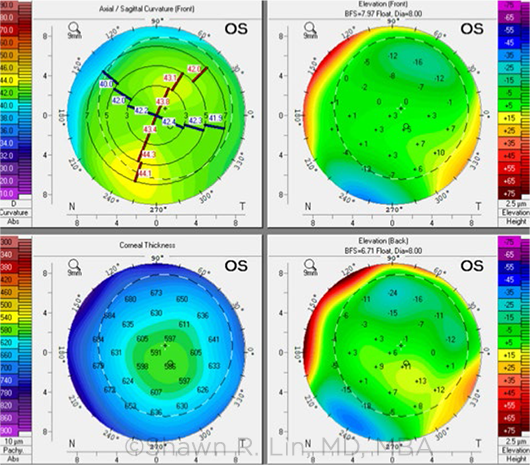Download PDF
This month, News in Review highlights selected papers from the original papers sessions at AAO 2019. Each was chosen by the session chairs because it presents important news or illustrates a trend in the field. Only four subspecialties are included here; papers sessions will also be held in six other fields. For more information, see the Mobile Meeting Guide.
Researchers in Boston and Los Angeles have developed an artificial intelligence (AI) neural network to calculate IOL power. The predictive ability of this approach significantly improved on the accuracy of several existing IOL formulas in mean error, mean absolute error, and target accuracy.
While most traditional formulas are based on large datasets, “they are generally engineered by humans or built using regression analysis,” said lead author Shawn R. Lin, MD, MBA, at the University of California, Los Angeles. And although several existing formulas are AI-based, their technology is licensed to biometry companies, so their methods are not well publicized, he said. “We wanted to show that this type of research can be done with off-the-shelf hardware and free software.”
 |
TOPO MAP. Data from 9,185 cataract surgeries were used with off-the-shelf hardware and free software to develop an AI-based formula.
|
Built on past results. For this retrospective cohort study, researchers used billing data to identify 9,185 cataract surgeries performed by 96 surgeons at Massachusetts Eye and Ear between 2016 and 2018. The formula is based on a subset of selected cases.
Data from those cases were fed into a software program, Google TensorFlow, to develop and train a neural network capable of predicting IOL power. In addition to postoperative refraction, the parameters included axial length, keratometry, anterior chamber depth, lens thickness, white to white, age, and sex.
Outsmarting existing models. The AI algorithm yielded significantly better results than the other IOL formulas it was compared to, including the Barrett Universal II, Hoffer Q, Holladay 1, and SRK/T.
Using the AI formula, 85% of eyes were within 0.50 D of target, and 97% were within 1.00 D of target. With the Barrett Universal II formula, the next closest in performance, 80% of eyes were within 0.50 D, and 95% were within 1.00 D.
Calculating the outliers. The predictive power can only get better with the inclusion of more eyes to the database, said Dr. Lin. He plans to start a multicenter data collection effort to expand the dataset to introduce variation across patient populations, geography, and technologies. Additional validation with data from more eyes will ensure that the formula works at the extremes of patient biometry measurements. “These are scenarios where all formulas have difficulty,” he said.
Gearing up for prime time. Once this AI model is ready for clinical practice, surgeons will be able to input a patient’s information and the formula will calculate the correct IOL power, Dr. Lin said. For now, he is using the formula alongside other existing formulas for each of his patients. “Comparing the post-op results allows me to continuously improve the formula.”
Dr. Lin plans to share this model and methodology with the research community as soon as possible. “I believe there is value in sharing our techniques so that we can spur others to do research in this field. Ultimately, I hope to improve cataract surgery outcomes for patients everywhere.”
—Miriam Karmel
|
An AI-Based Approach to Predicting IOL Power. Presented during the first cataract original papers session. When: Sunday, Oct. 13, 3:30-5:30 p.m. Where: South 152. Access: Free.
|
___________________________
Relevant financial disclosures—Dr. Lin: None.
For full disclosures and the disclosure key, see below.
Full Financial Disclosures
Dr. Hamada None.
Dr. Lin None.
Ms. Shoshany None.
Dr. Swaminathan None.
Disclosure Category
|
Code
|
Description
|
| Consultant/Advisor |
C |
Consultant fee, paid advisory boards, or fees for attending a meeting. |
| Employee |
E |
Employed by a commercial company. |
| Speakers bureau |
L |
Lecture fees or honoraria, travel fees or reimbursements when speaking at the invitation of a commercial company. |
| Equity owner |
O |
Equity ownership/stock options in publicly or privately traded firms, excluding mutual funds. |
| Patents/Royalty |
P |
Patents and/or royalties for intellectual property. |
| Grant support |
S |
Grant support or other financial support to the investigator from all sources, including research support from government agencies (e.g., NIH), foundations, device manufacturers, and/or pharmaceutical companies. |
|
More from this month’s News in Review